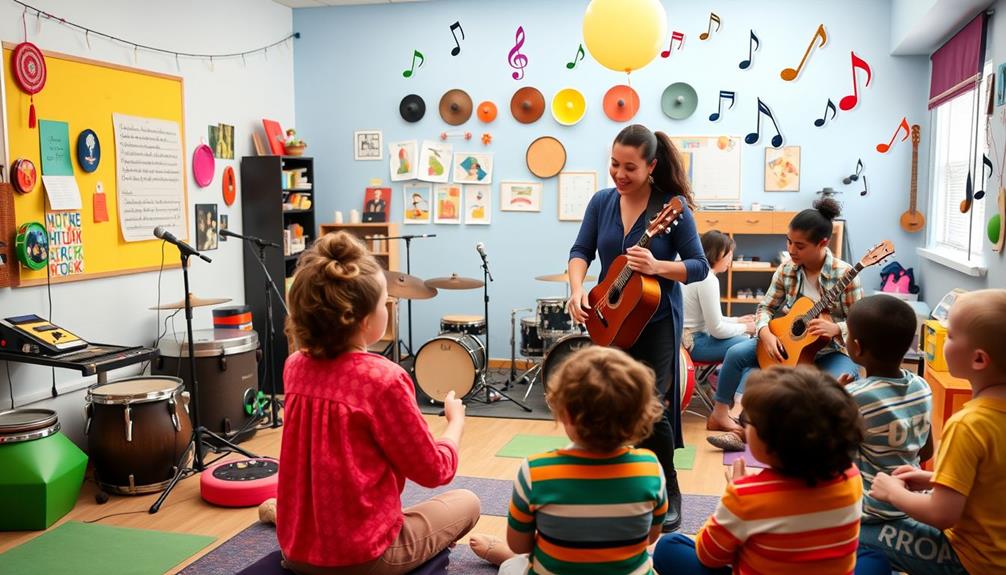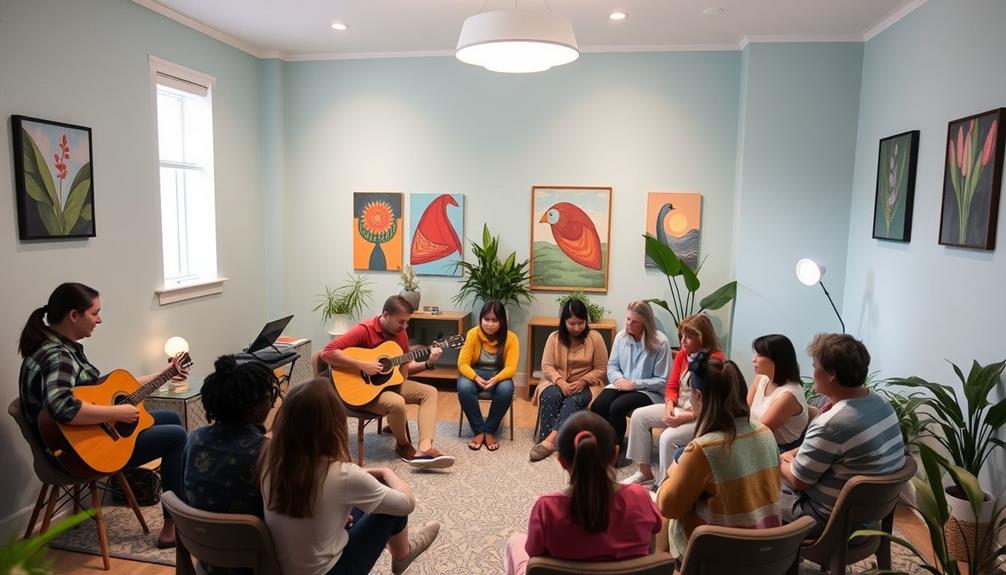Music plays an essential role in occupational therapy by enhancing client outcomes. About 84% of therapists use music to improve participation and social skills. Engaging in musical activities can boost mood and reduce pain perception, making therapy more enjoyable and effective. Techniques like singing, instrument playing, and songwriting foster communication, fine motor skills, and emotional expression. You'll find that music also benefits clients with specific needs, such as those managing dementia or recovering from strokes. As you explore more, you'll discover how music therapy can elevate the overall therapeutic experience. Additionally, research has shown how music impacts brain function by stimulating neural pathways associated with memory, attention, and emotional regulation. This neurological engagement is particularly beneficial for clients with cognitive impairments, as it helps reinforce existing skills and fosters new learning. By integrating music into therapy, practitioners can create meaningful and transformative experiences tailored to each client’s unique needs.
Key Takeaways
- Music therapy significantly improves mood, with a 69.96% mean change reported post-treatment sessions in occupational therapy.
- Engaging in musical activities enhances social skills, with 86.67% of clients showing improved social engagement.
- Incorporating music into therapy increases participation in leisure activities, observed by 80% of practitioners.
- Music aids in managing dementia, with 51.56% of practitioners reporting reduced sundowning behaviors after interventions.
- The integration of music supports cognitive and emotional regulation, enhancing overall quality of life for clients.
Benefits of Music Therapy
Music therapy offers a unique avenue for enhancing various aspects of occupational therapy, greatly impacting clients' overall well-being. One of the primary benefits of music therapy is its ability to improve mood. Practitioners report an impressive 69.96% mean change in mood after treatment sessions, allowing you to feel more positive and motivated. This boost in mood can considerably affect your mental health, promoting a sense of stability and joy.
Additionally, safe exercises during pregnancy can be complemented by music therapy, creating a holistic approach to wellness.
Additionally, engaging in music therapy enhances social skills. With 86.67% of respondents noting improvements in clients' social engagement, you'll find it easier to connect with others and participate in group activities. This social participation is essential, as it fosters a sense of community and belonging.
Moreover, music therapy encourages involvement in leisure activities. About 80% of practitioners have observed greater participation in these pursuits, making your recreational time more enjoyable and fulfilling.
For individuals with dementia, music therapy effectively manages sundowning behaviors, with 51.56% of practitioners reporting a decrease in these symptoms post-intervention.
Fundamentally, the benefits of music therapy are vast, enhancing your overall experience in occupational therapy and improving your quality of life.
Techniques for Integration

Incorporating music therapy into occupational therapy sessions can greatly enhance the therapeutic experience. By integrating various music activities, you create a calming environment that fosters focus and engagement.
For instance, occupational therapists can use singing activities to improve breath support and language skills, especially beneficial for clients facing communication challenges. Additionally, incorporating yoga techniques for relaxation can further support the calming effects of music therapy.
Playing musical instruments is another effective technique. It helps develop fine motor skills and coordination, essential for individuals recovering from injuries or surgeries.
Additionally, improvisation in music therapy allows clients to express themselves creatively, exploring emotions and thoughts in a supportive setting.
Another valuable approach is songwriting, which serves as a therapeutic technique that fosters communication and emotional regulation. It provides clients with a creative outlet for expressing their feelings, making it especially useful for those on the autism spectrum disorder.
Music for Pain Management

How can music serve as a powerful tool for pain management in occupational therapy? Engaging in music therapy can greatly reduce your perception of pain by diverting your attention from discomfort through enjoyable musical activities like listening, singing, or playing instruments.
Research shows that slow tempo music promotes relaxation and stress reduction, making it a key component of effective pain management strategies. In addition, the incorporation of AI-generated music in therapeutic settings can personalize the musical experience, allowing for tailored interventions that cater to individual preferences and needs.
Structured musical activities not only distract you from pain but also enhance your overall emotional well-being, which can additionally alleviate discomfort. In fact, 51.56% of occupational therapy practitioners have reported decreased sundowning behaviors in dementia patients when music was utilized as an intervention, showcasing its effectiveness in both pain management and emotional regulation.
Moreover, the rhythmic cues provided by music can aid your physical rehabilitation exercises, improving coordination and balance—particularly beneficial for stroke recovery patients experiencing pain.
Resources for Practitioners

Accessing a wealth of resources can greatly enhance your practice as an occupational therapy practitioner utilizing music interventions. By tapping into these valuable tools, you can help improve your clients' skills in a fun and engaging way.
Additionally, exploring vegan alternatives can provide unique insights into health-focused interventions that may resonate with clients. Here are some key resources to evaluate:
- American Music Therapy Association (AMTA): Offers research-based resources and professional development opportunities for effective music interventions.
- Certification Board for Music Therapists (CBMT): Provides certification and continuing education, keeping you updated on best practices in the field.
- World Federation of Music Therapy (WFMT): Establishes global standards for music therapy, facilitating international collaboration.
In addition, the National Coalition of Creative Arts Therapies Associations (NCCATA) shares valuable information and promotes collaboration among professionals.
Therapy & Wellness Connection also provides resources for teaching social skills through music, ensuring extensive support for practitioners.
Innovations in Therapy Practices

The integration of music therapy techniques within occupational therapy practices is transforming the way practitioners engage with clients and address their rehabilitation needs. You'll find that 84% of occupational therapists now incorporate music in therapy sessions. This shift leads to a remarkable 69.11% mean change in occupational participation among clients, demonstrating the effectiveness of using music.
Essential tools for creating structured musical activities not only enhance motor skills but also show an impressive 86.67% improvement in social participation. For older adults, particularly those experiencing dementia, music plays a significant role in reducing sundowning behaviors, with 51.56% of practitioners witnessing significant improvements.
As you explore these innovations, consider how interdisciplinary approaches that combine music with traditional rehabilitation models can boost cognitive and emotional regulation in therapy. By embracing these techniques, you can create a more dynamic and engaging environment for your clients.
Incorporate music into your practice, and you'll likely see enhanced outcomes, fostering a stronger connection with those you serve. Ultimately, the integration of music in occupational therapy isn't just a trend; it's a powerful tool that enhances the rehabilitation journey for clients of all ages.
Frequently Asked Questions
How Does Music Help in Therapy?
Music helps you engage more fully in therapy sessions, boosts your mood, and enhances social interactions. It encourages participation through activities like dancing and reminiscing, making your therapeutic experience more enjoyable and effective overall.
Why Is Listening Important in Occupational Therapy?
Listening's like a gentle breeze, guiding you through therapy. It sharpens focus, lifts your mood, and eases anxiety. By immersing yourself in sound, you engage more fully, transforming challenges into melodies of progress and healing.
What Is the Role of Music Therapy in Rehabilitation?
Music therapy plays an essential role in rehabilitation by enhancing mood, encouraging social interaction, and improving participation in activities. You'll find it effective for managing symptoms and fostering engagement through various musical activities and interventions.
What Is the Application of Music as a Therapeutic Tool?
Imagine your favorite song lifting your spirits on a tough day. Music's a therapeutic tool that boosts mood, enhances communication, and engages you, transforming challenges into opportunities for growth and connection in your daily life.
Conclusion
In the end, you might think music therapy is just about jamming out to your favorite tunes, but it's so much more than that. It's a powerful tool that can enhance healing and improve lives in ways you never imagined. So, next time you're humming a song, remember it's not just a catchy tune—it might just be the key to someone's recovery. Who knew that belting out lyrics could be as essential as physical therapy?









